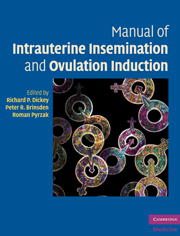Book contents
- Frontmatter
- Contents
- List of contributors
- Preface
- 1 An overview of intrauterine insemination and ovulation induction
- 2 Male causes of infertility: evaluation and treatment
- 3 Female causes of infertility: evaluation and treatment
- 4 Clinic and laboratory design, personnel and equipment
- 5 Semen analysis: semen requirements for intrauterine insemination
- 6 Semen preparation for intrauterine insemination
- 7 Ovulation induction for intrauterine insemination I: oral drugs clomiphene, tamoxifen, letrozole
- 8 Ovulation induction for intrauterine insemination II: gonadotropins and oral drug–gonadotropin combinations
- 9 Ultrasonography in the management of ovulation induction and intrauterine insemination
- 10 Insemination technique and insemination complications
- 11 Cryopreservation
- 12 Donor sperm
- 13 The role of the nurse in intrauterine insemination and ovulation induction
- 14 Complications of ovulation induction I: high-order multiple births, miscarriage, ectopic pregnancy, congenital anomalies, ovarian cancer
- 15 Complications of ovulation induction II: ovarian hyperstimulation syndrome, ovarian torsion
- 16 The psychological issues of intrauterine insemination
- 17 Ethical, legal and religious considerations of artificial insemination
- Index
13 - The role of the nurse in intrauterine insemination and ovulation induction
Published online by Cambridge University Press: 01 February 2010
- Frontmatter
- Contents
- List of contributors
- Preface
- 1 An overview of intrauterine insemination and ovulation induction
- 2 Male causes of infertility: evaluation and treatment
- 3 Female causes of infertility: evaluation and treatment
- 4 Clinic and laboratory design, personnel and equipment
- 5 Semen analysis: semen requirements for intrauterine insemination
- 6 Semen preparation for intrauterine insemination
- 7 Ovulation induction for intrauterine insemination I: oral drugs clomiphene, tamoxifen, letrozole
- 8 Ovulation induction for intrauterine insemination II: gonadotropins and oral drug–gonadotropin combinations
- 9 Ultrasonography in the management of ovulation induction and intrauterine insemination
- 10 Insemination technique and insemination complications
- 11 Cryopreservation
- 12 Donor sperm
- 13 The role of the nurse in intrauterine insemination and ovulation induction
- 14 Complications of ovulation induction I: high-order multiple births, miscarriage, ectopic pregnancy, congenital anomalies, ovarian cancer
- 15 Complications of ovulation induction II: ovarian hyperstimulation syndrome, ovarian torsion
- 16 The psychological issues of intrauterine insemination
- 17 Ethical, legal and religious considerations of artificial insemination
- Index
Summary
Introduction
The fertility nurse is an essential member of a multi-professional team whose focus is to ensure the delivery of quality care to patients. Information regarding ovulation induction (OI) and intrauterine insemination (IUI) is introduced to the patient by multiple team members, but most importantly by the nurse. The nurse works with the physicians and other team members, and becomes the primary advocate for the patient.
After the physician designs a plan of treatment based on his or her initial assessment and diagnosis, it is the nurse who coordinates and implements the plan of treatment. During the planning phase, the nurse becomes the primary caregiver and has the majority of interaction with the patient. The nurse's role is to direct couples through their treatment by explaining and defining all procedures and instructions clearly and concisely. It is very important for the nurse to be knowledgeable, compassionate, confident and empathetic.
The nurse implements the physician's plan of treatment by formulating and reviewing the OI patient's cycle calendar, ordering and instructing on the administration of oral or injectable medications, and educating on potential risks and/or side effects. The nurse teaches the patient the purpose of each step in the treatment protocol. The nurse reviews results of ultrasound and labs, and then communicates these results with the physician so as to instruct the patient with her plan of treatment. The nurse has an important role in teaching the patient regarding ovulation predictor kits.
Occasionally the nurse's role includes discussion of costs involved.
- Type
- Chapter
- Information
- Manual of Intrauterine Insemination and Ovulation Induction , pp. 138 - 140Publisher: Cambridge University PressPrint publication year: 2009

